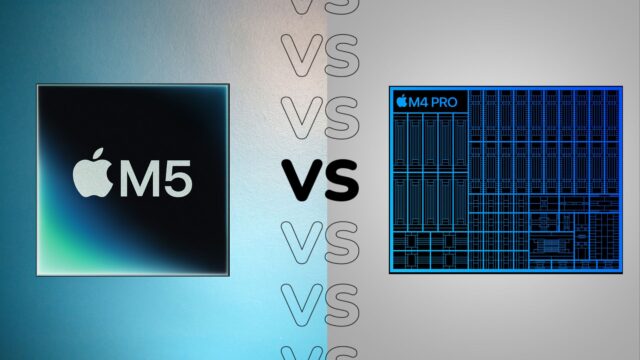Apple’s latest silicon, the M5 chip, promises to deliver the “next big leap in AI performance”.
With Neural Accelerators for AI workloads, an increase in graphics and the “world’s fastest CPU core”, Apple hails the M5 as able to bring more capabilities to the likes of MacBook Pro, iPad Pro and even Apple Vision Pro.
But how does M5 compare to M4 Pro? If you’re sporting last year’s MacBook Pro M4 Pro, should you even consider upgrading?
We’ve picked apart the specs of both the M5 and M4 Pro and highlighted the key differences between the Apple processors below.
M4 Pro has a 14-core CPU for performance
Apple promises that both its M5 and M4 Pro chips feature the “world’s fastest CPU core”, although the chips differ in their respective make-up. The M5 has up to a 10-core CPU, made up of six efficiency and up to four performance cores, which Apple says deliver “up to 15 percent faster multithreaded performance” over the standard M4 chip.
As we’re yet to review the M5 chip, we can’t confirm this claim just yet.
On the other hand, the M4 Pro features an up to 14-core CPU that’s made up of 10 performance and four efficiency cores. This, Apple claims, is up to 1.9x faster than the M1 Pro and up to 2.1x faster than the Core Ultra 7 258V (as of October 2024).

M4 Pro has double the GPU cores of the M5
The M4 Pro’s GPU boasts up to 20 cores for graphics performance, which is not only 2x that of the M4 but also of the new M5 chip. That’s not to say that the M5’s 10-core GPU isn’t impressive. In fact, Apple explains that the 10-core GPU features a Neural Accelerator in each core, which should deliver over a whopping 4x peak GPU compute compared to M4.
Not only that, but Apple says users can also expect up to 30% faster graphics performance compared to M4, too.
Otherwise, the M4 Pro’s GPU promises to make the likes of building and testing apps in Xcode faster, while pro 3D renderers should be able to produce imagery in less time than before.


M5 includes Apple’s third-gen ray-tracing engine
Sporting Apple’s third-generation ray-tracing engine, the M5 should offer up to a whopping 45% graphics uplift in apps using ray tracing. This is especially appealing to gamers, as it helps light behave more like it does in the real world.
Similarly, the M4 Pro chip also features an improved hardware-accelerated ray-tracing engine within its GPU, helping games look more lifelike and compelling than its predecessor.
M5 powers the latest Vision Pro
Keen to experience the M5’s prowess yourself? Fortunately, the chip can be found in many recently launched flagship products, such as the iPad Pro M5, MacBook Pro M5 and even the Apple Vision Pro.
On the other hand, you can find the M4 Pro chip in iterations of the MacBook Pro and Mac Mini.


M4 Pro supports up to 64GB of memory
M4 Pro boasts support of up to 64GB of memory alongside 273GB/s of memory bandwidth, which Apple says is 75% more than the 2023 M3 Pro. The M5, on the other hand, offers up to 32GB and 153GB/s of memory bandwidth, which is a 30% increase over the M4.
Although there’s a clear difference between the two, both should still provide a speedy performance and allow for seamless multitasking between apps too.
However, remember that not all devices will see such a high amount of memory. For example, the recently announced iPad Pro M5 has 12GB of memory, whereas the MacBook Pro M5 sees the full promise of 32GB.
Early Verdict
Although we’re yet to review the M5 ourselves, its specs certainly make the chip seem like an appealing choice for those in the market for a new tablet or MacBook. That said, the M4 Pro remains a powerful choice for those with a more intense workload, and it’s unlikely worth upgrading at this point.











